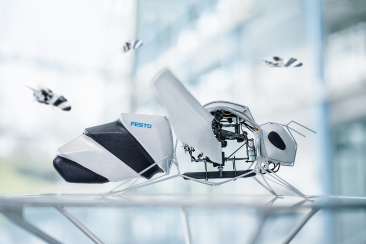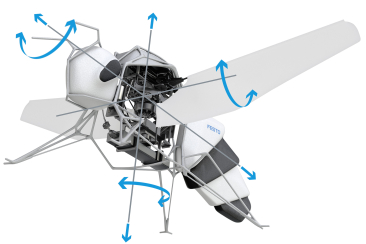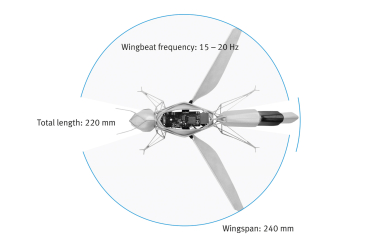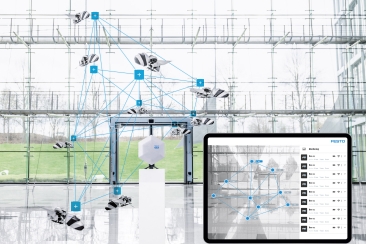
Volo autonomo in uno sciame
Con un peso di circa 34 grammi, una lunghezza di 220 millimetri e un'apertura alare di 240 millimetri, il BionicBee è l’oggetto volante più piccolo creato dal Bionic Learning Network. Per la prima volta, gli sviluppatori hanno utilizzato il metodo del design generativo: dopo aver inserito solo alcuni parametri, un'applicazione software utilizza principi di progettazione definiti per trovare la struttura ottimale che utilizzi la minima quantità di materiale possibile, mantenendo comunque una costruzione stabile. Questa costruzione leggera è essenziale per una buona manovrabilità e tempo di volo.
Volo autonomo in uno sciame
Il comportamento autonomo dello sciame di api viene raggiunto grazie ad un sistema di localizzazione indoor, con tecnologia ultra-wideband (UWB). A tal fine, otto ancoraggi UWB sono installati nello spazio su due livelli. Ciò consente una misurazione precisa del tempo e permette alle api di localizzarsi nello spazio. Gli ancoraggi UWB inviano segnali individuali alle api, consentendo loro di misurare autonomamente le distanze e calcolare la propria posizione nello spazio utilizzando i timestamp.
Per volare in uno sciame, le api seguono percorsi specificati da un computer centrale. Per garantire un volo sicuro e privo di collisioni, è necessario un elevato grado di precisione spaziale e temporale. Nella pianificazione del percorso, è necessario tenere conto dell'interazione reciproca, attraverso la turbolenza dell'aria "downwash".
Poiché ogni ape è realizzata a mano e anche le più piccole differenze di produzione possono influenzare il suo comportamento di volo, le api hanno una funzione di calibrazione automatica: dopo un breve volo di prova, ogni ape determina i suoi parametri di controllo ottimizzati. L'algoritmo intelligente può quindi calcolare le differenze hardware tra le singole api, consentendo di controllare l'intero sciame da esterno, come se tutte le api fossero identiche.
Festo è un attore globale e un'azienda indipendente a conduzione familiare con sede a Esslingen am Neckar, in Germania. Fin dagli inizi Festo ha stabilito degli standard nella tecnologia dell'automazione industriale e nella formazione tecnica, contribuendo così allo sviluppo sostenibile dell'ambiente, dell'economia e della società. Prodotti e servizi sono disponibili in 176 paesi del mondo. L'azienda, infatti, fornisce tecnologia di automazione pneumatica ed elettrica a 300.000 clienti di automazione di fabbrica e di processo in oltre 35 industrie. Il settore LifeTech con la tecnologia medica e l'automazione di laboratorio sta diventando sempre più importante. Con circa 20.600 dipendenti in oltre 250 filiali in circa 60 paesi in tutto il mondo, Festo ha realizzato un fatturato di circa 3,45 miliardi di euro nel 2024. Ogni anno oltre l'8% di questo fatturato viene investito in ricerca e sviluppo, mentre l'1,5 % del fatturato è investito nella formazione di base e di perfezionamento. Festo Didactic SE è un fornitore leader di formazione e formazione tecnica e offre ai suoi clienti in tutto il mondo soluzioni complete di apprendimento digitale e fisico in ambiente industriale.





